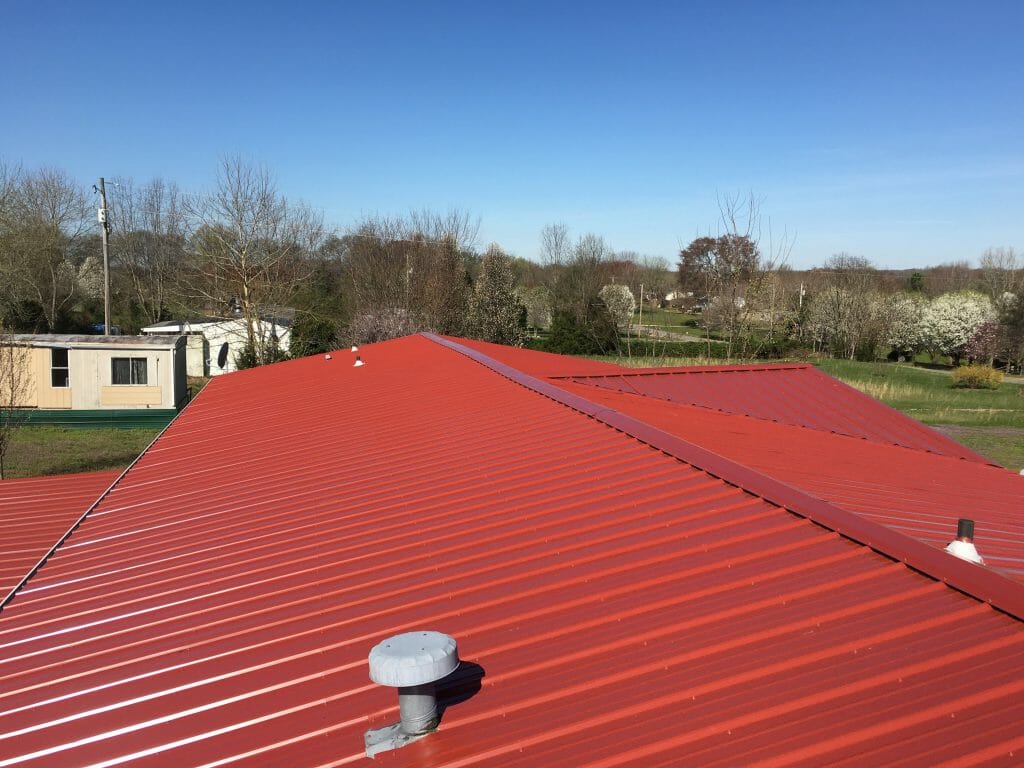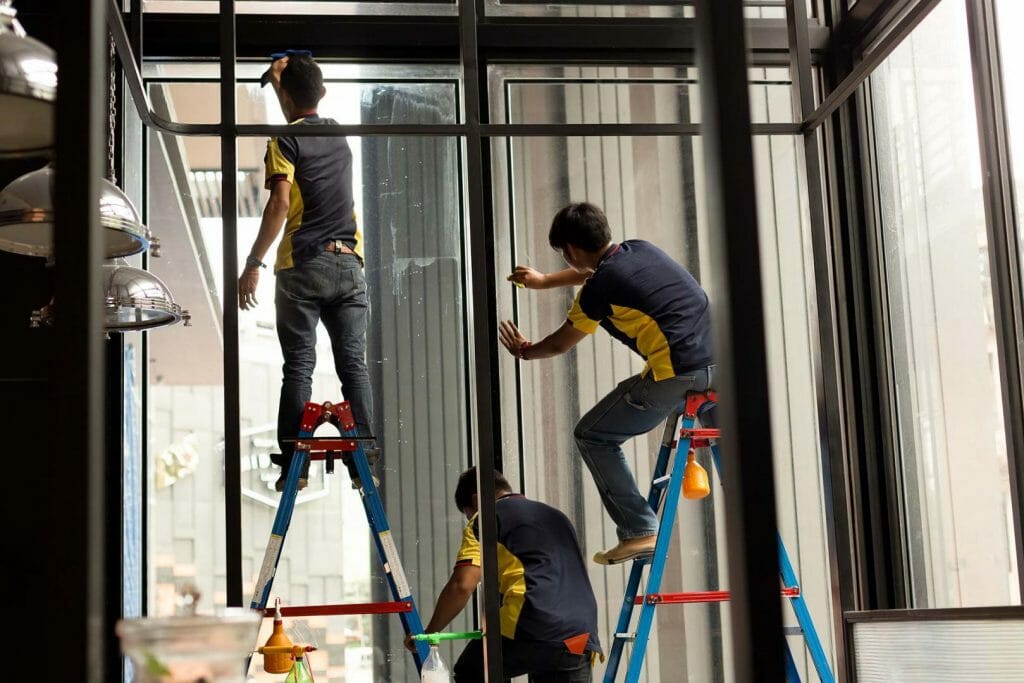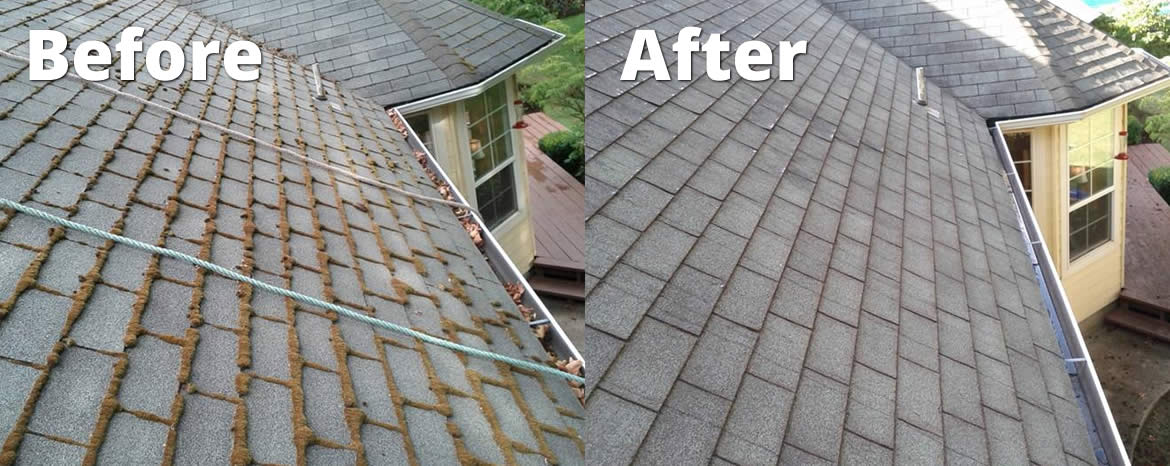When you own a house, it always seems to be something to do, inside or…
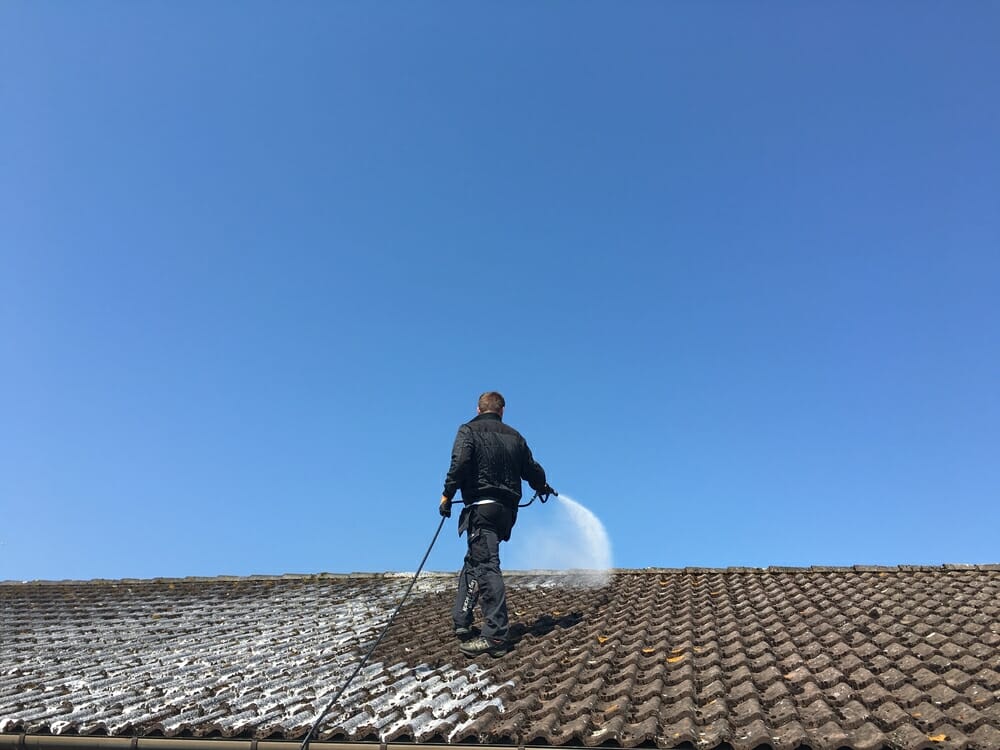
Welcome to Clearly Amazing’s Ulitmate Guide To Roof Cleaning. This guide will cover everything you wanted to know about roof cleaning and more. Feel free to read through or use the links below to jump around the document:
How Do You Know If Your Roof Needs to be Cleaned?
Roof Cleaning Pricing Insights
Webster’s dictionary describes a roof as “the structure forming the upper covering of a building or vehicle.” For the purposes of this Ultimate Guide we will stay focused on roofs that cover buildings. Obviously roofs are ubiquitous, both from a commercial and a residential perspective. We spend the vast majority of our time underneath roofs – whether at home, work, or play. And roofs come in all shapes and sizes. Roofs are important because they keep the outside elements outside – including rain, sleet, snow, hail, and heat. A house that does not keep the moisture out is a house that will literally rot from the inside out.
Roofs come in many different shapes and sizes. This guide will focus on roofs commonly found in North America, as this guide is intended to inform the reader on how those roofs may be cleaned. Some of the main roof shapes that are found in the US include flat roofs, pyramid hip roofs, gable roofs, shed roofs, and curved roofs. Key characteristics of each include:
ROOF SHAPE
Flat roofs: These types of roofs are becoming more popular because they give the homeowner more space on top of the home. These types of roofs also help keep homes cooler and can be a great way to capture rainwater. Flat roofs require less materials as shingles are not required. They are also typically stronger than pitched roofs from a structural perspective. Flat roofs are also typically safer for maintenance – as there is much less risk of falling off the roof. At the same time, expect more maintenance with such a roof as it dirt and debris will tend to accumulate on the roof. When there is a problem, your contractor can walk the area quickly to provide an assessment. With a pitched roof this may require a ladder, harnesses, etc.
Note: Flat roofs still carry about a 10 degree slope, necessary to keep moisture from pooling on the surface.
Pyramid hip roof: This kind of roof has four sides that are slanted – these sides meet at one point. This type of roof does not have ridges, which is an advantage in that it minimizes the risk of leaks. The roof eaves also are popular because of the shade they provide. Hipped roofs are known for their strength and ideal in very windy climates.
Gable roof: This is probably the most popular roof style. The main feature is two sloping sides that meet at the top. Gable roofs are designed to prevent the build up of snow in colder climates. There are many different styles of gable roofs including front gable, cross gable, and Flemish gable.
Curved roof: Curved roofs are modern looking and typically made of steel. They require a professional to do a careful design, however, since the slope needs to allow for water and snow run-off.
ROOF MATERIALS
Each shaped roof will use different materials. Most common materials include:
Asphalt shingles: These come in many different shapes and sizes. Prices range from affordable to high-end luxury that can mimic cedar shake or slate materials.
Metal roofing: Metal roofs, if properly maintained, can last 40-100 years. Only copper roofs last longer.
Wood shake: Cedar shake roofs are good for the environment, aesthetically pleasing, and provide a more natural look to the home. These types of roofs are only possible on a sloped roof surface.
Slate: Slate is one of the oldest types of material used for houses and can last over 100 years. Made from natural stone, these roofs can be extremely heavy, making proper planning and design important when choosing such a roof material.
EPDM Flat Roofing: EPDM stands for Ethylene Propylene Diene Monomer. This is a rubber membrane that is very popular for commercial use. Because it is affordable, more and more homeowners are also choosing it for residential purposes.
This list is certainly not exhaustive. There are many other roof types like solar tiles, stone-coated steel, rubber slate, clay and concrete tiles, built-up roofs, and green roofs. The different materials and shapes have evolved over the years to address consumer’s expectations for price and style. In addition, different roof types and materials are more common in certain areas because of environmental factors. As an example, it is very common to find tile roofs in the Pacific Southwest whereas an asphalt roof is much more common in the Northeast.
The climate, as well as the material, plays a big role in determining how often a roof needs to be cleaned and with what method. For example, roof cleaning in the Pacific Northwest is a large and thriving industry, as the consistent moisture and temperature leads to an ideal environment for moss and other fungi. On the other hand, roof cleaning is much less common (and far less frequent) in the Pacific Southwest where the climate is much drier.
Reasons to clean a roof
Now that we’ve had a brief background on why roofs are important and the kinds of roofs that are most popular, let’s dive into the topic of cleaning the roof.
There are a variety of reasons to clean the roof of your home or business. Roofs that are not cleaned look dirty and unsightly, affecting property values and angering HOAs. Roofs that are not cleaned eventually become damaged from excess plant growth and debris – leading to leaking and rotting of the actual roof structure. Dirty roofs can also become an insurance liability – in some instances, insurance companies will mandate roof cleaning as a prerequisite for issuing a policy.
Some of these reasons will resonate with the reader and some will not. However, the foremost reason is one that few can argue against. That is, maintaining your roof protects the investment of the roof – prolonging its life and mitigating the need for a replacement.
Roof replacement can be extremely expensive. It is also disruptive to your family and the neighborhood. A roof that needs to be replaced can put the occupants and their belongings at risk. For a single-family dwelling, expect to pay at least $20,000 for a roof replacement and often times a multiple of this number.
Keeping your roof clean is not primarily an aesthetic endeavor. Roofs need to be cleaned regularly to minimize and control the infestation of pesticides.
Three of the primary culprits are algae, lichen, and moss. These organisms can live on your roof and literally eat away at the roofing substances.
Algae: One of the most common, and most problematic types of roof algae is gloeocapsa magma (GM). Algae is a bacterium that feeds off both asphalt and limestone found in the shingle material. As the limestone filler is eaten away, the shingles lose their effectiveness to reflect heat rays. Since light is not reflected accurately, the roof temperature rises much faster leading to increased air-conditioning bills.
The Asphalt Roofing Manufacturing Association reports that the spores from this type of algae can be moved by wind or by animals. This means that it can quickly spread within a neighborhood, particularly if it is a wet climate.
As a colony of GM grows, the older algae decompose and retain moisture, which allows the unit to grow even faster.
The second type of common roof growth is moss. Moss is dark green, holds lots of moisture, and its roots can reach in and damage shingles. These roots are called rhizoids. It is also unsightly and makes even a well-designed roof look old and worn.
Lichen: Lichen is actually just a combination of algae and fungus. Although lichen doesn’t trap water like moss, it is acidic and can penetrate into and damage the roof shingles.
Example of Gloeocapsa Magma
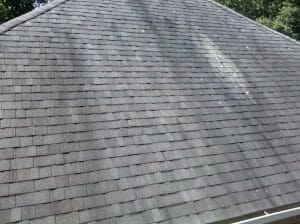
Example of Moss Growth on a roof
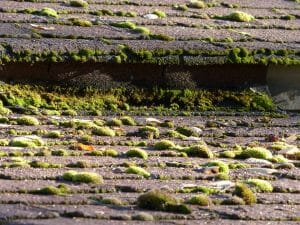
Example of Lichen on a roof
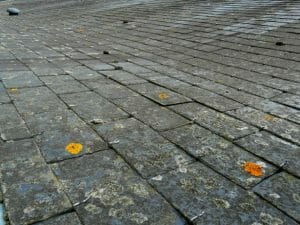
Roof Cleaning Process
There are a variety of ways that roofs can be cleaned to treat the growth of algae, moss, and lichen. In the last ten years a cottage industry has developed specifically to address this need.
Since the industry is relatively new, it’s important for the consumer to be educated before making a purchasing decision. Regular maintenance can prolong the life of your roof five plus years, so maintenance can be well worth the investment. That having been said, roof cleaning can run into the thousands (depending on the size and difficulty of the roof).
This paper will attempt to give an overview so that the reader can make an informed decision when it comes to their own home.
Roof Blow
This technique is exactly as it sounds. Using either leaf blowers or high pressure air blowers, the debris on the roof is blown off. Cosmetically, the more visible debris can be removed including leaves, sticks, and moss. The homeowner can see an instant difference in the condition of the roof.
Pros: Can be done relatively quickly, takes care of larger debris, makes a huge cosmetic difference. Inexpensive as it can be done with a leaf blower.
Cons: Doesn’t remove the underlying problem, organisms remain on the roof and will continue to grow and return. Requires someone on the roof and, if the roof is pitched, may require temporary anchors or a tie-off to be done safely. Will not remove ugly algae streaks.
What to expect when you buy this service:
Contractor will typically arrive with 1-2 technicians and backpack blowers. Less sophisticated technicians will use ladders to climb onto the roof but will not tie off with anchors (very dangerous and not recommended). Roof will be blown off of all debris. If the weather has been fairly dry, this can happen quite quickly. If it’s been rainy, it may take some time to remove leaves and other vegetation. Some contractors will then rake up the debris and remove it from the premises, often they will not even do this.
How long will it last:
A roof blow is a cosmetic fix. If the leaves are down, it may stay fairly clean during the entire winter. But the mold, lichen, and fungi have not been killed. They are still eating at your roof’s surface and will continue to grow. Structurally nothing has been fixed.
What to ask for, at a minimum:
If this is your preferred cleaning method, require the technicians to tie-off with anchors / harnesses on your roof. Also, confirm that they will pick up and haul away any debris that is blown off the roof. Finally, ask them to guarantee that they will clean out the gutters as part of the roof-blow (otherwise you may just move the problem from one location to another).
Pressure Wash
Many contractors will attempt to pressure wash the roof. Using long hoses to reach the roof, the contractor will use high pressure to remove the growth and clean the surface.
Pros: Cosmetically it can make a roof appear cleaner quite quickly.
Cons: Dangerous to use high-pressure when standing on a roof. The high pressure can destroy the shingles of the roof as it removes the limestone filler (if asphalt) and for other types of tiles can lift and break them if the proper technique is not used. Using a pressure washer often voids the warranty on most roofs. The biggest disadvantage of the pressure washer is that it does not eliminate the growth on the roof as the microscopic life remains. It simply removes the visible layer temporarily. The growth will return shortly, making this a temporary fix at best.
What to expect when you buy this service:
Contractor will get up on the roof with a pressure washer. Some will use long hoses so that they do not have the actual machine on the roof, rather just the nozzle. Others will actually take a pressure washer with a surface cleaner and use this up on the roof. Pressure washing is time intensive as every single surface requires attention.
How long will it last:
Depends on the skill of your technician. If he is not experienced, he may do more damage to the roof while he is up there than good. For example, if he does not angle the pressure nozzle correctly he will lift / break tiles. If he presses too closely to the surface of the roof he will remove the limestone granules (if an asphalt roof). If the technician is skilled, he can clean the roof and you should expect that it will cosmetically look very nice. The moss and mold will grow back immediately, however, since essentially the roof has been watered (and these organisms love moisture).
What to ask for, at a minimum:
We recommend against any pressure washing on the roof. It puts the technician at risk, it voids the warranty of your roof, and it can damage your tiles. The disadvantages far outweigh any short-term cosmetic benefits that may be found. If you still feel compelled to use a pressure washer, then make sure that the technicians tie off or use harnesses (especially with a surface cleaner). Additionally, require that they give you their proof of worker’s compensation certificate before beginning. Finally, ensure that they are aware that any damage to the tiles you will charge against the cost of the work.
Application of Zinc Oxide
Another popular approach is the application of zinc oxide. This can be done using zinc strips or applying the powder to the roof. The metal is toxic to algae, moss, lichen and many other types of common plant life found on roofs. The particles are spread across the roof by rain and they work to kill the plants. Over time, rain water will wash the dead plants down the roof and into the gutter system.
Pros: This method will kill the organisms growing on your roof. However, the application of zinc oxide is not attractive on the roof. In the absence of rain, it looks like a white powder. It conditions are windy, the zinc oxide can blow off the roof and then not be effective in killing the plant growth. Since it is a powder, it often can only be a spot treatment solution which, if not probably covering the entire roof, will just result in re-growth. Remember, the plant growth is often microscopic. Just because you are not able to see it doesn’t mean there are not organisms flourishing on your roof.
What to expect when you buy this service:
Contractor will get up on the roof with either a pump sprayer or just use gloves to actually distribute the powder on the roof. The zinc oxide will be a white powdery substance that will cover the roof. While it is not cosmetically appealing, it is effective in killing the moss. However, the powder will remain on the roof until the next rainfall. It can be a real eyesore for the neighborhood.
How long will it last:
Depends on the skill of your technician. The powder must be spread across the entire roof in order to kill the visible moss and fungi. Spot treatment is not effective as it tends to miss growing areas that may not yet be visible. In general, if you use this treatment plan on doing it at least once a year to contain and minimize re-growth.
What to ask for, at a minimum:
Ask that the technician use a roof harness when spreading the material. Make sure that your price includes the price of the zinc-oxide (some companies will charge separately). Ensure that the application is for the entire roof – if you are doing a spot treatment the price should be much lower. As for a guarantee against re-growth, ask for a minimum of a year. So if within the next year there is growth, the company should warranty and come back to reapply at no additional charge.
Roof Soft Wash
A growing and more popular method is the application of a diluted bleach solution to the roof followed by a rinse with water. The solution completely kills everything on the roof. In fact, many contractors provide three to five year warranties against regrowth.
Pros – Soft wash approach completely kills the organisms growing on your roof. Will not void the warranty of the roof as the application is done with low pressure (equivalent to a garden hose pressure), thus ensuring the integrity of the roof. The best solution to maintaining a clean roof for an extended period.
Cons – Requires a trained expert to ensure proper chemical mixture and application. More expensive than other approaches because of this expertise. If done incorrectly, the chemical application can damage or kill lawn landscaping.
What to expect when you buy this service:
Typically a softwash crew will consist of two technicians. One person will be on the roof or up on a ladder applying the solution to the roof. The second technician will be on the ground spraying down plants and vegetation with water to ensure that nothing that receives spray dies.
The technician on the roof will first harness up and walk the roof to understand the key areas that need attention. Thicker moss or vegetation will be swept off the roof with a soft bristle brush broom (NOT scraped). After the heavier debris has been taken off the roof the technician will then apply a bleach solution to the entire roof. The application is done with the pressure of a garden hose. Depending on the pitch of the roof, this application may be done from the ladder at the base of the roof. In other instances, the applicator may be on the roof for this work. Note that in some states a pesticide license is actually required to apply this solution. Because, as we have already pointed out, we are not just cleaning dirt! It’s actually pesticides on the roof that are being killed and removed. This application (when properly mixed) will kill the majority of organisms living on the roof within 10 minutes. The customer will be able to note a marked difference in the moss on the roof as it will start to wither and change colour. Note, however, that it will not look immediately clean. Rather, the solution will kill the growth and then, over the course of the coming 4-6 weeks, the growth will die and be washed off by rainwater.
Upon completion of the solution application, the applicator will then rinse the roof with water.
How long will it last:
The roof cleaning should last, in most cases, two to three years. Factors such as humidity, access to sunlight, and annual precipitation play a factor. Also, if the neighbours are not keeping up their roofs it will be easier for spores in the air to be transferred back onto the customer’s roof. But generally speaking, there should be little to no growth on the roof for at least 24 months.
What to ask for, at a minimum:
Ensure that the technicians are properly harnessed if they are on your roof and/or that they tie off the ladders. Request proof of insurance and 1-2 references that you can contact (even if you decide not to actually call them) just so that you can get comfortable that the company is experienced working in such an environment. And ask for a guarantee – a minimum of two years that they will come back and spray again if the moss grows back.
How Do You Know If Your Roof Needs to be Cleaned?
This is an important question because often customers wait until permanent damage has already occurred. If the black streaks on your roof have been there several years or if the moss is already several inches tall, it’s possible that some of the shingle damage is irreparable.
Remember that the organisms living on the roof are largely microscopic. As they grow and multiply they become more visible to the human eye. Catching problems early will not only save the homeowner money on the cleaning, but it will also avoid damage that cannot be undone.
If your home has lots of shade during the day, this will be a sign that it is more prone to the growth of algae and moss. This will mean that preventative maintenance needs to be on the calendar.
If you see signs of black streaks, or areas where there is an accumulation of leaves and sticks, this is another sign to inspect the roof.
Finally, if you’ve had lots of rain recently and you notice a strain on the gutters, make sure you do not forget to check the roof. If the gutters begin to pull away from the home they can put excess strain and wear on the roof.
To summarize, a regular visual inspection of your roof can help the homeowner spot problems early. However, it is not recommended to wait for trouble areas. Instead, plan for regular maintenance of your roof – at minimum once a year. We recommend you choose a trusted professional to do a spot inspection and provide you with their suggestions / insights. Many roofing contractors will do this at no charge to the homeowner (in hopes of winning your business when the need is apparent).
Homeowner Considerations
We’ve reviewed the most common types of roofs found in the United States and popular cleaning methods. There are a few questions that a homeowner should answer before choosing how to address your own roof.
1) Is this something that I am prepared to do myself?
If the homeowner is fit and willing, it may be a DIY project. If you do decide to clean the roof yourself, make sure you take all necessary safety precautions. Specifically, a roof harness and anchor should be used on any sloped roof. A helmet and eye protection should also be worn – particularly if chemicals are to be distributed.
As a rule of thumb, we recommend that you hire a professional to clean your roof. There are inherent risks in this type of work and roof cleaning is not a job to be done alone. If you are adamant about making it happen (for economic or purely the love of the outdoors) make sure you plan the project thoroughly and with at least one other person.
Note: There are several helpful websites that walk through the DIY approach – one recommended article can be found here: https://www.familyhandyman.com/roof/roof-repair/how-to-clean-roof-stains/.
2) If the homeowner determines that this project should be outsourced, the next step is to determine the preferred roof-cleaning method. Here are a few helpful suggestions when weighing your approach:
Figure out how long you plan to live in the home. If long-term, think more carefully about a process that will effectively kill the growth on your roof and keep it off. If short-term (if you are moving, leasing or selling the home) the homeowner may choose a more cosmetic approach.
Don’t void your roof’s warranty. Pressure washing should be avoided regardless of how long you plan to live in the home as it can permanently damage the shingles and reduce the value of the roof.
Ask a few contractor’s to give you an on-site bid. As them to provide their assessment of the roof’s condition and their suggestions for how to attack the project.
3) Once you’ve determined whether to do the work yourself and the type of cleaning method you will employ, then it is time to choose a vendor. Here are best practices to make sure you find a reliable contractor.
Request their insurance information. Anyone that is getting on your roof needs to have worker’s compensation and a minimum $1M general liability policy. If they cannot provide copies then they are probably not operating a legitimate business and it is not worth the liability.
Ask for two recent references. Call those references to confirm that they had work done and were satisfied with the outcome.
Ask for the company’s safety plan for your home. Do they plan to use harnesses? Will they tie off their employees on the roof? If they aren’t willing to take care of their own team, how much care do you think they will give your roof?
- Pay upon completion and with a check or credit card. Don’t pay in advance for services as you leave yourself exposed to a contractor who never comes back.
- After you’ve selected a vendor – make sure your home is ready for the scheduled work to be done.
- Ensure that the contractor has easy access to a water spigot on the outside of your home.
- Check to make sure that the water is turned on and working properly.
- Make sure that there is access to all four sides of the home – remove objects that may impede moving easily around the property.
- Confirm that all doors are unlocked for quick access and that any animals are inside during the actual cleaning.
- Move your vehicle away from the home so that there is no risk of chemical spray
- Make sure you are home upon completion of the work so you can walk the property with the vendor and make sure everything is done to your expectations!
Roof Cleaning Pricing Insights
Depending on the sophistication of your contractor, there are typically four main points that the companies will take into consideration before submitting a bid:
- Pitch of the roof
- Roof material
- Condition of the roof
- The overall complexity of the job
A few points on each.
Pitch of the roof. The pitch, or steepness, of the roof, determines how the roof can be safely cleaned. The pitch is defined as how many inches the roof rises vertically for every 12 inches of horizontal run. The higher the pitch, the less likely that your technician will actually set foot on the roof. Any pitch over 9/12 is considered to be steep. Most residential homes are designed with pitches between 4/12 and 9/12. For steep roofs, your contractor will try to limit their time walking on the roof. This means your roof will require either a lift or ladder setups around the home to effectively be cleaned. A lift will cost upwards of $400 per day, additional ladder setups will also increase the price as it will take longer to complete the cleaning. If roof access is required, you may need to have anchors installed on your roof. The anchors can then be used for the technicians to tie in and harness. Note: let a professional install the roof anchor! Expect to pay between $50-100 for a temporary anchor.
Roof material. Asphalt or concrete roofs are more straight-forward to clean as the technicians can move more freely about the surface. With a tile roof, each step must be careful and measured so as to no break tiles. A cedar room will require special shoes called corkers. Since a cedar roof is more fragile and can be easily damaged, working on the roof should be avoided to the greatest extent possible.
Condition of the roof. Most professionals will want to see the roof to gauge their current condition. Expect to pay more if it has been years since anything has been done to the roof. If an extensive brushing needs to be done, you will be charged for this work. The more time on the roof that is needed, the greater the surcharge.
The overall complexity of the job. The contractor will want to understand access to water (to hook up their equipment), ability to reach the roof (vegetation or other obstacles) and general height, steepness, and layout of the roof. Roofs with multiple ledges or outcroppings will be harder to clean and thus require more time.
These four factors will weigh into the price that you receive. We encourage consumers to reach out to multiple providers. Look for how long they have been in service, their reviews, their follow-up and availability, and their willingness to work with you on scheduling and price.

